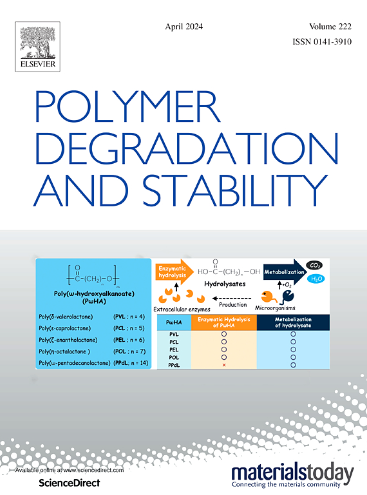Thermal decomposition mechanisms of phosphorus flame retardants: A combined theoretical and experimental approach
IF 7.4
2区 化学
Q1 POLYMER SCIENCE
引用次数: 0
Abstract
Phosphorus flame retardants (PFRs) are one of the main candidates for a fully organic, sustainable replacement to traditional halogenated FRs. However, their unexpected decomposition remains an open challenge hindering their full potential for sustainable applications in polymers. To address this issue, thermal decomposition of two common PFRs, namely 6H-Dibenz[c,e][1,2]oxaphosphorin, 6-[(1-oxido-2,6,7-trioxa-1-phospha bicyclo[2.2.2]oct‑4-yl)methoxy]-, 6-oxide (DOPO-PEPA) and Aflammit PCO 900 (AF), was studied using density functional theory (DFT) coupled with experimental methods, particularly the direct inlet probe-mass spectrometry (DIP-MS). The DIP-MS spectra were processed and analyzed using algorithms to identify potential decomposition products of DOPO-PEPA and AF. Under inert atmospheric conditions, bond dissociation and proton attack were identified as the predominant decomposition pathways. Geometries of intermediates, transition states, and products along potential energy surfaces were identified through DFT calculations. For DOPO-PEPA, the dissociation of the C![]() O bond linking the DOPO and PEPA moieties was identified as the most kinetically favored dissociation pathway; while for AF, bond dissociation was found energetically demanding. On the other hand, protonation processes demonstrate more dependence on the availability of protons. Cross-validating computational results with experimental observations verified the pathways through which DOPO-PEPA and AF release phosphorus-containing species and other decomposition products. Benefitting from a combination of fundamental molecular models and experimental evidence, this study provides new insights into the molecular mechanisms of thermal degradation of PFRs, thus providing a template for developing new FRs with enhanced thermal stability.
O bond linking the DOPO and PEPA moieties was identified as the most kinetically favored dissociation pathway; while for AF, bond dissociation was found energetically demanding. On the other hand, protonation processes demonstrate more dependence on the availability of protons. Cross-validating computational results with experimental observations verified the pathways through which DOPO-PEPA and AF release phosphorus-containing species and other decomposition products. Benefitting from a combination of fundamental molecular models and experimental evidence, this study provides new insights into the molecular mechanisms of thermal degradation of PFRs, thus providing a template for developing new FRs with enhanced thermal stability.

磷系阻燃剂的热分解机理:理论与实验相结合的方法
磷系阻燃剂(PFRs)是替代传统卤化阻燃剂的主要有机、可持续替代品之一,但其意外分解仍然是一个开放的挑战,阻碍了其在聚合物中的可持续应用。为了解决这一问题,采用密度泛函理论(DFT)结合实验方法,特别是直接入口探针质谱法(DIP-MS),研究了两种常见的PFRs (6H-Dibenz[c,e][1,2] oxphosphorin,6 -[(1- oxide -2,6,7-trioxa-1-phospha bicyclo[2.2.2]oct‑4-yl)甲氧基]-,6-oxide (DOPO-PEPA)和Aflammit PCO 900 (AF))的热分解。利用DIP-MS谱对DOPO-PEPA和AF的潜在分解产物进行了处理和分析。在惰性大气条件下,键解离和质子攻击是主要的分解途径。通过DFT计算,确定了中间产物、过渡态和生成物沿势能面的几何形状。对于DOPO-PEPA,连接DOPO和PEPA基团的CO键的解离被确定为最有利的动力学解离途径;而对于AF,键解离需要能量。另一方面,质子化过程更依赖于质子的可用性。计算结果与实验观察结果的交叉验证验证了DOPO-PEPA和AF释放含磷物质和其他分解产物的途径。本研究结合了基础分子模型和实验证据,为PFRs热降解的分子机制提供了新的见解,从而为开发具有增强热稳定性的新型FRs提供了模板。
本文章由计算机程序翻译,如有差异,请以英文原文为准。
求助全文
约1分钟内获得全文
求助全文
来源期刊

Polymer Degradation and Stability
化学-高分子科学
CiteScore
10.10
自引率
10.20%
发文量
325
审稿时长
23 days
期刊介绍:
Polymer Degradation and Stability deals with the degradation reactions and their control which are a major preoccupation of practitioners of the many and diverse aspects of modern polymer technology.
Deteriorative reactions occur during processing, when polymers are subjected to heat, oxygen and mechanical stress, and during the useful life of the materials when oxygen and sunlight are the most important degradative agencies. In more specialised applications, degradation may be induced by high energy radiation, ozone, atmospheric pollutants, mechanical stress, biological action, hydrolysis and many other influences. The mechanisms of these reactions and stabilisation processes must be understood if the technology and application of polymers are to continue to advance. The reporting of investigations of this kind is therefore a major function of this journal.
However there are also new developments in polymer technology in which degradation processes find positive applications. For example, photodegradable plastics are now available, the recycling of polymeric products will become increasingly important, degradation and combustion studies are involved in the definition of the fire hazards which are associated with polymeric materials and the microelectronics industry is vitally dependent upon polymer degradation in the manufacture of its circuitry. Polymer properties may also be improved by processes like curing and grafting, the chemistry of which can be closely related to that which causes physical deterioration in other circumstances.
 求助内容:
求助内容: 应助结果提醒方式:
应助结果提醒方式:


